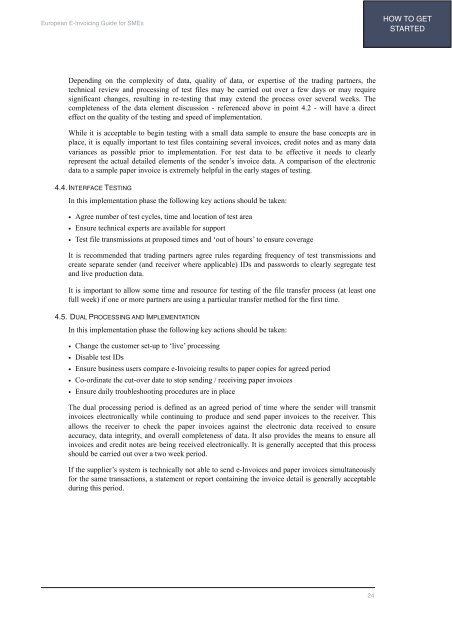Download the European e-Invoicing Guide for SMEs - Celeris Ltd.
Download the European e-Invoicing Guide for SMEs - Celeris Ltd.
Download the European e-Invoicing Guide for SMEs - Celeris Ltd.
You also want an ePaper? Increase the reach of your titles
YUMPU automatically turns print PDFs into web optimized ePapers that Google loves.
<strong>European</strong> E-<strong>Invoicing</strong> <strong>Guide</strong> <strong>for</strong> <strong>SMEs</strong><br />
Depending on <strong>the</strong> complexity of data, quality of data, or expertise of <strong>the</strong> trading partners, <strong>the</strong><br />
technical review and processing of test files may be carried out over a few days or may require<br />
significant changes, resulting in re-testing that may extend <strong>the</strong> process over several weeks. The<br />
completeness of <strong>the</strong> data element discussion - referenced above in point 4.2 - will have a direct<br />
effect on <strong>the</strong> quality of <strong>the</strong> testing and speed of implementation.<br />
While it is acceptable to begin testing with a small data sample to ensure <strong>the</strong> base concepts are in<br />
place, it is equally important to test files containing several invoices, credit notes and as many data<br />
variances as possible prior to implementation. For test data to be effective it needs to clearly<br />
represent <strong>the</strong> actual detailed elements of <strong>the</strong> sender’s invoice data. A comparison of <strong>the</strong> electronic<br />
data to a sample paper invoice is extremely helpful in <strong>the</strong> early stages of testing.<br />
4.4.INTERFACE TESTING<br />
In this implementation phase <strong>the</strong> following key actions should be taken:<br />
• Agree number of test cycles, time and location of test area<br />
• Ensure technical experts are available <strong>for</strong> support<br />
• Test file transmissions at proposed times and ‘out of hours’ to ensure coverage<br />
It is recommended that trading partners agree rules regarding frequency of test transmissions and<br />
create separate sender (and receiver where applicable) IDs and passwords to clearly segregate test<br />
and live production data.<br />
It is important to allow some time and resource <strong>for</strong> testing of <strong>the</strong> file transfer process (at least one<br />
full week) if one or more partners are using a particular transfer method <strong>for</strong> <strong>the</strong> first time.<br />
4.5. DUAL PROCESSING AND IMPLEMENTATION<br />
In this implementation phase <strong>the</strong> following key actions should be taken:<br />
• Change <strong>the</strong> customer set-up to ‘live’ processing<br />
• Disable test IDs<br />
• Ensure business users compare e-<strong>Invoicing</strong> results to paper copies <strong>for</strong> agreed period<br />
• Co-ordinate <strong>the</strong> cut-over date to stop sending / receiving paper invoices<br />
• Ensure daily troubleshooting procedures are in place<br />
The dual processing period is defined as an agreed period of time where <strong>the</strong> sender will transmit<br />
invoices electronically while continuing to produce and send paper invoices to <strong>the</strong> receiver. This<br />
allows <strong>the</strong> receiver to check <strong>the</strong> paper invoices against <strong>the</strong> electronic data received to ensure<br />
accuracy, data integrity, and overall completeness of data. It also provides <strong>the</strong> means to ensure all<br />
invoices and credit notes are being received electronically. It is generally accepted that this process<br />
should be carried out over a two week period.<br />
If <strong>the</strong> supplier’s system is technically not able to send e-Invoices and paper invoices simultaneously<br />
<strong>for</strong> <strong>the</strong> same transactions, a statement or report containing <strong>the</strong> invoice detail is generally acceptable<br />
during this period.<br />
24<br />
HOW TO GET<br />
STARTED


